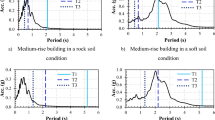Abstract
The common practice in industry is to perform flutter analyses considering the generalized stiffness and mass matrices obtained from finite element method (FEM) and aerodynamic generalized force matrices obtained from a panel method, as the doublet lattice method. These analyses are often re-performed if significant differences are found in structural frequencies and damping ratios determined from ground vibration tests compared to FEM. This unavoidable rework can result in a lengthy and costly process of analysis during the aircraft development. In this context, this paper presents an approach to perform flutter analysis including uncertainties in natural frequencies and damping ratios. The main goal is to assure the nominal system’s stability considering these modal parameters varying in a limited range. The aeroelastic system is written as an affine parameter model and the robust stability is verified solving a Lyapunov function through linear matrix inequalities and convex optimization.










Similar content being viewed by others
Notes
The range of variation of each xth frequency can be computed by \((1 - \delta _x)^{1/2}\) and \((1 + \delta _x)^{1/2}\), where \(\delta _x\) is the associated parameter.
References
Theodorsen T (1935) General theory of aerodynamic instability and the mechanism of flutter. Technical Report 496, NACA National Advisory Committee for Aeronautics
Bisplinghoff HA, Raymond L, Halfman RL (1996) Aeroelasticity. Dover, New York
Theodorsen T, Garrick IE (1940) Mechanism of flutter A theoretical and experimental investigation of the flutter problem. Technical Report 685, NACA National Advisory Committee for Aeronautics
Hassig HJ (1971) An approximate true damping solution of the flutter equation by determinant iteration. J Aircr 8(11):885–889
Karpel M (1981) Design for active and passive flutter suppression and gust alleviation. Technical Report 3482, National Aeronautics and Space Administration—NASA
Li P, Yang Y, Lu L (2014) Nonlinear flutter behavior of a plate with motion constraints in subsonic flow. Meccanica. doi:10.1007/s11012-014-0041-8
Impollonia N, Muscolino G (2002) Static and dynamic analysis of non-linear uncertain structures. Meccanica 37:179–192
Albano E, Rodden WP (1969) A doublet-lattice method for calculating lift distributions on oscillating surfaces in subsonic flows. AIAA J 7:279–285
Lind R, Brenner M (1999) Robust aeroservoelastic stability analysis. Springer, London
Chung C, Shin S, Kim T (2008) A new robust aeroelastic analysis including aerodynamic uncertainty from varying Mach numbers. AIAA structures, structural dynamics, and materials conference
Chung C, Shin S (2010) Worst case flutter analysis of a stored wing with structural and aerodynamic variation. AIAA structures, structural dynamics, and materials conference
Peeters B, Climent H, Diego R, Alba J, Ahlquist JR, Carreno JM, Hendricx W, Rega A, Garcia G, Deweer J, Debille J (2008) Modern solutions for ground vibration testing of large aircraft. IMAC—international modal analysis conference
Borglund D (2004) The mu-k method for robust flutter solutions. J Aircr 41:1209–1216
Karpel M, Moulin B, Idan M (2003) Robust aeroservoelastic design with structural variations and modeling uncertainties. J Aircr 40:946–954
Moulin B (2005) Modeling of aeroservoelastic systems with structural and aerodynamic variations. AIAA J 43:2503–2513
Allemang RJ (2002) The modal assurance criterion (MAC): twenty years of use and abuse. IMAC-XX—conference & exposition on structural dynamics—smart structures and transducers
Ewins DJ (2000) Modal testing, theory, practice and application, 2nd edn. Research Studies Press Ltd, Baldock
Gahinet P, Apkarian P, Chilali M (1994) Parameter-dependent Lyapunov functions for real parametric uncertainty. IEEE Trans Autom Control 41(3):436–442
Boyd S, El Ghaoui L, Feron E, Balakrishnan V (1994) Linear matrix inequalities in system and control theory. SIAM studies in applied mathematics, Philadelphia
Barmish BR (1985) Necessary and sufficient conditions for quadratic stabilizability of an uncertain system. J Optim Theory Appl 4:399–408
Bueno DD, Marqui CR, Goes LCS (2012) Robust stability analysis and identification of flutter. UNCERTAINTIES—international symposium on uncertainty quantification and stochastic modeling
Goncalves PJP, Bueno DD, Goes LCS (2012) Analysis of aeroelastic stability in continuous flight envelope and parameter uncertainty using linear matrix inequalities. ERMAC—Encontro Regional de Matemática Aplicada e Computacional
Boukas EK (2008) Control of singular systems with random abrupt changes. Springer, Berlin
Yates EC (1988) AGARD standard aeroelastic configurations for dynamic response I-wing 445.6. Advisory Group for Aerospace Research and Development—AGARD
Pahlavanloo P (2007) Dynamic aeroelastic simulation of the AGARD 445.6 Wing using Edge. FOI—Swedish Defence Research Agency Defence and Security, System and Technology
Roger K (1977) Airplane math modelling methods for active control design. In: Structural aspects of active control, AGARD conference proceedings 9:4.1–4.11
Author information
Authors and Affiliations
Corresponding author
Appendices
Appendix: State space submatrices
This appendix presents the submatrices \(\bar{\mathbf{A}}_j\) previously shown in Eq. (9).
Aerodynamic forces in time domain
The state space model was obtained considering the unsteady aerodynamic forces written in time domain through the Roger’s rational function approximation shown in Eq. (26). Additional details can be found in reference [26].
for which the parameters \(\beta _{j}\) were previously chosen to keep the aeroelastic frequency and damping ratios computed by the pk-method for the nominal system. The generalized displacement vector \(\mathbf{u}_{m}\) is used to define the state space vector \(\mathbf{x}_{m} = \left\{ \dot{\mathbf{u}}_{m} \;\; \mathbf{u}_m \;\; \mathbf{u}_{am(1)} \ldots \mathbf{u}_{am(n_{lag})} \right\} ^T\). The Laplace variable is \(s\) and \(\mathbf{u}_{am(j)}\) is the \(j\)th vector of state of lags.
Rights and permissions
About this article
Cite this article
Bueno, D.D., Góes, L.C.S. & Gonçalves, P.J.P. Flutter analysis including structural uncertainties. Meccanica 50, 2093–2101 (2015). https://doi.org/10.1007/s11012-015-0138-8
Received:
Accepted:
Published:
Issue Date:
DOI: https://doi.org/10.1007/s11012-015-0138-8




